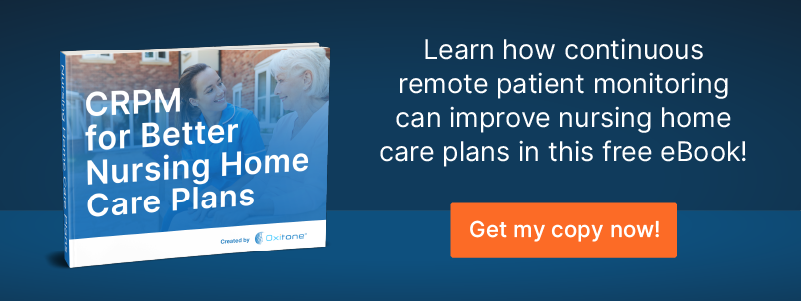With technological advances evolving in medical applications, new possibilities and enhanced accuracy of diagnosis have become a reality that drastically improves patient care. Recently developed remote patient monitoring devices now offer wearable continuous remote patient monitoring (CRPM), providing streamlined features that include predictive alerts and the real-time recording of health data. For at-risk patients and those who require a high level of medical care, CRPM devices are saving lives and improving quality of life in unprecedented ways.
In this article, you will learn the role that continuous remote patient monitoring devices play in patient care compared to traditional medical care. We will also discuss how continuous remote patient monitoring devices can improve care and their role in saving lives. Last, we will examine how Oxitone’s 1000M wearable device represents a leading solution in telehealth.
The Role Continuous Remote Patient Monitoring Devices Play in Enhanced Patient Care
Patient care with continuous remote patient monitoring devices represents an evolution in monitoring patient vital signs. In the past, traditional remote monitoring presented substandard care for high-risk patients, even exacerbating complex medical scenarios and needlessly exposing individuals to communicable diseases. Patients with this type of care could potentially receive adverse effects, such as increased anxiety and heart rate from self-administered misdiagnosis.
Comparatively, modern continuous remote patient monitoring devices provide patients with several clear benefits that have revolutionized healthcare for professionals and patients. Better outcomes and more accurate diagnoses are just a few of these benefits.
Let’s take a look at an overview of the benefits of CPRM devices.
How Continuous Remote Patient Monitoring Improves Patient Care and Saves Lives
- Continuous remote patient monitoring empowers patients by providing greater accuracy when describing a patient’s symptoms that develop over a timeline or occur during certain activities. If a patient’s heart rate increases during certain activities or from triggering stimuli, continuous remote patient monitoring devices can record this data and avoid potential exposure in the future. This can be a great benefit for at-risk patients who want to safely pursue a regular exercise regimen or remain in the workforce within their current abilities, for example.
- CPRM devices are designed with the latest technological advances, including artificial intelligence (AI), deep learning, and other emerging technologies for the best in patient healthcare. As technology improves, these devices will incorporate these advances to provide better response times for medical emergencies, predictions about a patient’s health in the near future, etc.
- Anxiety management for patients can be superior with continuous remote patient monitoring, reducing overall anxiety and uncertainty for health. Leaving these worries to a dedicated CPRM device improves a patient’s outcome, particularly for those with chronic issues and susceptibility to stress. This avoids “negative feedback loops,” where uncertainty and misdiagnosis lead to worsening states of health.
- Continuous remote patient monitoring reduces the number of unnecessary hospital visits, which in turn, reduces patient care costs and optimizes clinical time. With visits to medical facilities and hospitalization being expensive, CPRM devices reduce hospital overcrowding while being cost-effective for patients. Due to sanitary conditions being uncertain in many medical facilities, unnecessary exposure to communicable disease is significantly reduced.
- Compatibility issues are eliminated with highly adaptable continuous remote patient monitoring devices and procedures. As technology develops, software updates for devices enable wearers to access modern care without running into obstacles for data access, unattainable patient records needed in emergencies, etc.
- At-risk patients who wear CPRM devices benefit from instant alerts should their health become life-threatening. Having a wearable device that encourages hospitalization or immediate medical attention can extend a patient’s life. For example, if a wearer has a stroke but appears normal, the remote patient monitoring device can call emergency services when every second matters.
About Oxitone
Now that you understand the benefits of CRPM and its devices, Oxitone has developed the world’s first device that brings these possibilities to patients in need. Offering a full-suite medical continuous care solution cleared by the FDA, Oxitone 1000M is a wearable monitoring device specifically designed for in-home use for patients.
Featuring enhanced usability and reliability, the 1000M is designed with FlexSense™, an elastic optical aperture that provides superior comfort and superior monitoring continuity. The Oxitone 1000M generates smart notifications that never disturbs with false or random notifications, requiring five levels of verification before initiating an alert. This continuous remote patient monitoring functionality provides enhanced care during home treatment of mild complications, post-acute events and rehabilitation processes, and more.
For patients with severe chronic conditions, the Oxitone 1000M drastically improves overall patient health, clinical management and outcomes, and patient quality of life and is a passive monitoring solution with high patient compliance.
For these reasons and more, continuous remote patient monitoring devices from Oxitone are the first choices in optimal patient care. Learn more about Oxitone 1000M, and speak with a representative today for the best healthcare on the market.
Here at Oxitone, we boost value-based healthcare by delivering extraordinary patient, clinical, and economical outcomes at reduced medical utilization and cost. Patients need a prompt response to emergencies. Physicians need an easy and timely follow-up with patients. Our mission is to transform chronic disease management and help save lives worldwide.
Let’s save lives together! To see how we help remote patient monitoring companies and physicians improve the management and care of high-risk patients, contact us today!


